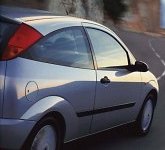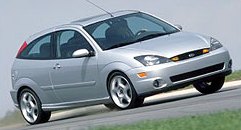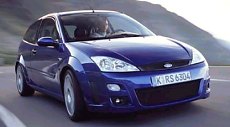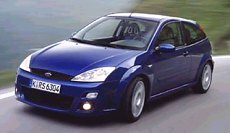 When
Ford discarded the long-serving "Escort" name for its family hatchback,
you know this car must be a revolution. Yes, the new Focus is the most
radical car in this class I have ever seen, bar the Mercedes A-class.
It
has eye-catching New Edge styling, it has a revolutionary rear
multi-link
suspension, it offers class-leading interior space wrapping in a
well-finished
package, it has handling and ride to insult Volkswagen Golf.... No
wonder
Ford gives it a new name. When
Ford discarded the long-serving "Escort" name for its family hatchback,
you know this car must be a revolution. Yes, the new Focus is the most
radical car in this class I have ever seen, bar the Mercedes A-class.
It
has eye-catching New Edge styling, it has a revolutionary rear
multi-link
suspension, it offers class-leading interior space wrapping in a
well-finished
package, it has handling and ride to insult Volkswagen Golf.... No
wonder
Ford gives it a new name.
Packaging Ford says the
Focus offers
44mm and 77mm more front and rear leg room respectively than the
Escort,
while exterior dimensions just rise fractionally - 10 mm in length and
10 mm in width. Forget this, if you remember how dull the old Escort
was.
What I care is how the new car compares with the best rivals from
Volkswagen,
Opel, Peugeot etc. Here Ford give us some data :
Clever packaging gives Focus an edge in wheelbase over its rivals, yet it is considerably lighter. Looking at the Focus from outside, you may wonder how brilliant the New Edge design is. Normally, cars in this class are bounded by strict exterior dimensions while they have to optimize the interior room. The result is a boring shape. With New Edge, Focus looks very different from others. Its actual shape is still strictly defined by the practical needs, but all the attention is drawn to the eye-catching edges which look as aggressive as sports car. In particular, the upper edge of side windows curved steeply towards the tail, this delivers a strong sense of coupe. The triangular headlamps also adds the aggressive feel, although not necessarily suit everyone's taste. Engine Focus has a competitive range of engines. The marvellous 1.4-litres Zetec-SE four has been tweaked to 74 hp (down from Fiesta's 89hp) in order to optimize fuel economy and low speed torque (up 10%). Next up is a new 1.6 version of the Zetec-SE, with 99 hp and 105 lbft. It is no more powerful than rivals, but its smoothness, quietness and responsiveness are unmatchable, especially in high rev, thanks to its Yamaha-developed origin. Most people will chose the 1.6-litre. Then there are two Mondeo-derived Zetec-E engines. 1.8 litres and 2-litres output 113 hp and 128 hp respectively. Not as sweet as the Yamaha engine, though. Handling and ride
Test drive the Focus in Ford's test track reveals its great ability - great body control, sharp and accurate steering regardless of the car's attitude, absorbent and quiet ride in bumps. As Autocar said, Focus has become the class leader in this area, beating the long-time leader Peugeot 306 and the amazing new Opel Astra. Comfort Open the door and you'll be impressed by the easy access, thanks to the low door sill and big (yet light) doors. The cabin is very spacious, especially the generous leg and head room for rear passengers are unseen in this class. Golf, once again, loses painfully in this respect. Even the previous leader Renault Megane finds itself inferior. The half-bucket front seats are just as comfortable yet supportive. Driving position is as superb as sports cars. There is an eye-catching silver colour panel on the central console (just like Puma and Ka), whose shape is the most stylish I've ever seen in a family car. On which all the controls are placed ergonomically for easy getting used to. Surround the whole cabin are big windows which help all-round visibility. The only down side is the average-sized boot and, arguably, its high standard of build quality still lags behind the mighty Golf. Who else is not ? Conclusion For many many
years, we are
waiting for a perfect family car. Every time we were disappointed,
because
there are too much compromise in this kind of cars. Cost, for example,
is a constraint. Styling is another, since everybody wants to play
safe.
I highly admire Ford's determination and courage displayed in this
project.
Like Mondeo, the company spends a lot of money on Focus, to make it the
class leader in styling, handling, ride, engines, refinement,
comfort....in
other words, to make it the best in all areas. It succeeded. May we
wish
the Focus to be as successful in the market as Ford planned - 1 million
units global sales annually. Hard work always worth rewarding.
|
||||||||||||||||||||||||||||||
| The above report was last updated in 1998. All Rights Reserved. |
 Ford
claims Focus's chassis
as 15% more rigid than its rivals. This gives it an edge in handling
and
ride. For the suspensions, Focus introduced a revolutionary rear
suspensions
called "Control Blade Suspension", which is a derivative of multi-link
suspension. Unlike conventional multi-link, there is a wide, pressed
steel
trailing arm with cum hub carrier does the job of two longitudinal
locating
rods, also takes the place of an expensive cast knuckle. This allow the
suspension to offer the same level of body control in a lower cost.
While
all other rivals employed half-independent torsion beam suspension
(except
Honda Civic), Focus has a decisive advantage in handling and ride.
Ford
claims Focus's chassis
as 15% more rigid than its rivals. This gives it an edge in handling
and
ride. For the suspensions, Focus introduced a revolutionary rear
suspensions
called "Control Blade Suspension", which is a derivative of multi-link
suspension. Unlike conventional multi-link, there is a wide, pressed
steel
trailing arm with cum hub carrier does the job of two longitudinal
locating
rods, also takes the place of an expensive cast knuckle. This allow the
suspension to offer the same level of body control in a lower cost.
While
all other rivals employed half-independent torsion beam suspension
(except
Honda Civic), Focus has a decisive advantage in handling and ride.
 Since the
retirement of Peugeot 306, the crown for hot hatches has been shifted
to
Honda Civic Type R. European car makers are of course displeased, as
hot
hatch was the invention and the strength of European. If any one is
qualified
to challenge Type R, it must be Ford Focus. Since Focus stormed the
world
in 1999, it was seen as a true driver’s car as well as a sales winner -
2 things rarely compatible. What a pity, a high performance version was
originally not in the plan. It was not until the car was proved
successful
in both continents that Ford started thinking of a hot version. Anyway,
late is still better than nil. This car finally made its world debut in
early 2002. It is available in both USA and Europe, being called SVT
Focus
and Focus ST170 respectively. For your information, SVT (Special
Vehicle
Team) is the performance division of Ford Detroit and 170 implies its
maximum
horsepower. Can it finally gun down the Type R ?
Since the
retirement of Peugeot 306, the crown for hot hatches has been shifted
to
Honda Civic Type R. European car makers are of course displeased, as
hot
hatch was the invention and the strength of European. If any one is
qualified
to challenge Type R, it must be Ford Focus. Since Focus stormed the
world
in 1999, it was seen as a true driver’s car as well as a sales winner -
2 things rarely compatible. What a pity, a high performance version was
originally not in the plan. It was not until the car was proved
successful
in both continents that Ford started thinking of a hot version. Anyway,
late is still better than nil. This car finally made its world debut in
early 2002. It is available in both USA and Europe, being called SVT
Focus
and Focus ST170 respectively. For your information, SVT (Special
Vehicle
Team) is the performance division of Ford Detroit and 170 implies its
maximum
horsepower. Can it finally gun down the Type R ?
 Power.
More power is what Focus need to make itself a world-beating hot hatch.
Therefore Ford gives it a 2-litre turbocharged engine, 215 horsepower
and
229 pound-foot of torque to out-perform its hot hatch rivals. Wait a
minute
- the price is also up to £20,000 in UK, inevitably lifting it to
a higher segment and faces the mighty Japanese 4WD fireballs ranging
from
WRX to Evo VII. In contrast, the Focus RS - note that without
"Cosworth"
- relies on the front wheels and a mechanical LSD to put down all the
power
to ground. Can FWD beat 4WD?
Power.
More power is what Focus need to make itself a world-beating hot hatch.
Therefore Ford gives it a 2-litre turbocharged engine, 215 horsepower
and
229 pound-foot of torque to out-perform its hot hatch rivals. Wait a
minute
- the price is also up to £20,000 in UK, inevitably lifting it to
a higher segment and faces the mighty Japanese 4WD fireballs ranging
from
WRX to Evo VII. In contrast, the Focus RS - note that without
"Cosworth"
- relies on the front wheels and a mechanical LSD to put down all the
power
to ground. Can FWD beat 4WD?
 Now you
can see Focus RS
is not just more powerful than Focus ST170, but it is a much more
serious
driver’s car. In fact, you can already see this from the aggressive
look
of the RS - 65mm wider tracks by flared wheelarches, huge 18-inch
wheels,
wide and low-profile 225/40 tyres... if you have good eyes, you can see
a huge Brembo brakes (325mm front; 280mm rear) through the 5-spoke
alloys.
Now you
can see Focus RS
is not just more powerful than Focus ST170, but it is a much more
serious
driver’s car. In fact, you can already see this from the aggressive
look
of the RS - 65mm wider tracks by flared wheelarches, huge 18-inch
wheels,
wide and low-profile 225/40 tyres... if you have good eyes, you can see
a huge Brembo brakes (325mm front; 280mm rear) through the 5-spoke
alloys.